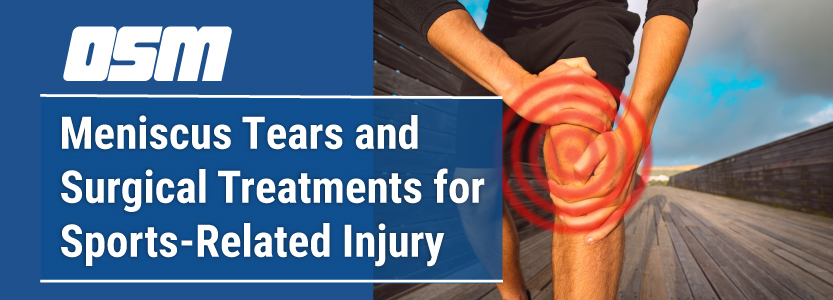Meniscus Tears and Surgical Treatments for Sports-Related Injury
Article featured on NY Orthopedics
A torn meniscus tear is one of the most common knee injuries found in athletes. These types of injuries commonly occur when the athlete twists their knee. Most meniscus tears are primarily found in athletes who perform in contact sports like football and rugby. However, active basketball players, skiers, and volleyball players are also at risk.
Below you’ll find some common symptoms of a torn meniscus, how to treat it, and the best and quickest ways to recover.
What Are the Common Symptoms of a Torn Meniscus
Your meniscus is a C-shaped piece of cartilage that sits between your shinbone and thighbone. It’s often referred to as the knee’s shock absorber, reducing the impact on your joint every time your foot makes contact with the surface.
Patients With a Torn Meniscus Report Experiencing:
- A popping sensation in their knee
- Swelling
- Stiffness
- Discomfort turning their knee
- Knees locking into place
- Difficulty straightening the knee
- Instability
Meniscus Tears in Athletes
In many cases, a torn meniscus will heal over time. Rest, medication, and physical therapy can speed recovery times in those cases where surgery is not necessary. In more severe cases, arthroscopic surgery may be required to repair the meniscus. This is more common in cases where the knee has locked into place.
Can You Play Sports With a Torn Meniscus
You should not continue to play sports if you are experiencing any torn meniscus symptoms. In fact, you should avoid any activity that may cause the knee to twist. If you’re experiencing any of the symptoms we’ve listed above, contact one of our qualified knee specialists for an examination as soon as possible to determine if they are related to a meniscus tear.
What Natural Methods Can I Perform to Heal a Torn Meniscus?
If your doctor chooses a non-surgical approach to heal your meniscus tear, they will likely recommend a combination of rest, ice, compression, and elevation, otherwise known as R.I.C.E.
- Rest – Keep off your knee as much as possible for the next couple of days. Putting pressure on your knee could aggravate your symptoms and limit your recovery time.
- Ice – Place an ice pack on your knee for 10 to 15 minutes a few times a day to reduce any swelling.
- Compression – Your doctor may recommend a wrap or brace to stabilize your knee until it fully heals.
- Elevation – Try to sit or lay back and elevate your knee above your heart. This will promote blood flow toward your heart which will aid in recovery.
What is the Recovery Time for Non-Surgical Torn Meniscus Treatments?
With any treatments, recovery can last around six to eight weeks; however, even minor tears may take longer to heal.
Torn Meniscus Surgery
In more severe cases, a doctor may recommend surgery. There are three main procedures a specialist may perform.
- Meniscus Repair – Your surgeon will perform an arthroscopy to determine the extent of the tear. From there, the surgeon will sew the torn pieces of the menisci back together.
- Trimming the Meniscus – Through an arthroscopy, a surgeon will trim back and remove any damaged cartilage, leaving the healthy cartilage intact.
- Meniscus Transplant – In some cases, a surgeon may choose to replace the meniscus with a healthy one from a donor. A patient must often meet several criteria to qualify for this type of treatment.
What is the Recovery Time For Torn Meniscus Surgery?
Recovery times can vary depending on the extent of the surgery. However, a healthy estimate is anywhere from six weeks to three months.
What are the Best Exercises After Meniscus Tear Surgery?
Your doctor will likely recommend light exercises to promote healing and improve your range of motion as you fully heal from your meniscus surgery. Here is just a sample of the types of torn meniscus exercises your doctor may recommend:
Hamstring Contractions:
Lie on your back with your knees bent and pull your heels in, tightening the muscles behind your thigh. Hold for five seconds and repeat ten times.
Straight Leg Raises:
Lying on your back, lift your outstretched leg about six inches off the ground. Hold for five seconds before lowering. Repeat ten times.
Standing Leg Raises:
Stand up using a railing or table for support. Slowly lift your leg forward, raising it about four to six inches off the ground. Gently lower your leg. Repeat ten times.
Can I Still Play Sports After Meniscus Surgery?
While each meniscus tear is different, the vast majority of patients who receive treatment will experience full mobility after treatment is complete. Athletes can continue playing the sports they love and stay competitive.
The Orthopedic & Sports Medicine Center of Oregon is an award-winning, board-certified orthopedic group located in downtown Portland Oregon. We utilize both surgical and nonsurgical means to treat musculoskeletal trauma, spine diseases, foot and ankle conditions, sports injuries, degenerative diseases, infections, tumors and congenital disorders.
Our mission is to return our patients back to pain-free mobility and full strength as quickly and painlessly as possible using both surgical and non-surgical orthopedic procedures.
Our expert physicians provide leading-edge, comprehensive care in the diagnosis and treatment of orthopedic conditions, including total joint replacement and sports medicine. We apply the latest state-of-the-art techniques in order to return our patients to their active lifestyle.
If you’re looking for compassionate, expert orthopedic and podiatric surgeons in Portland Oregon, contact OSM today.
Phone:
Address
17355 Lower Boones Ferry Rd Suite 100A
Lake Oswego, OR 97035
Hours
Monday–Friday
8:00am – 4:30pm



